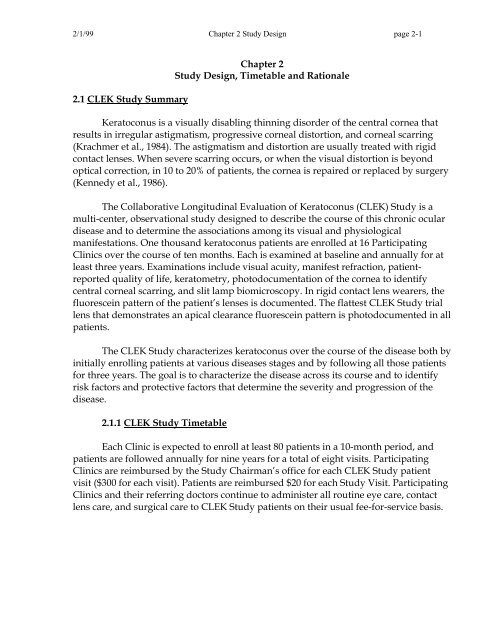OM t of c.iii - Vision Research Coordinating Center - Washington ...
OM t of c.iii - Vision Research Coordinating Center - Washington ...
OM t of c.iii - Vision Research Coordinating Center - Washington ...
Create successful ePaper yourself
Turn your PDF publications into a flip-book with our unique Google optimized e-Paper software.
2/1/99 Chapter 2 Study Design page 2-1<br />
2.1 CLEK Study Summary<br />
Chapter 2<br />
Study Design, Timetable and Rationale<br />
Keratoconus is a visually disabling thinning disorder <strong>of</strong> the central cornea that<br />
results in irregular astigmatism, progressive corneal distortion, and corneal scarring<br />
(Krachmer et al., 1984). The astigmatism and distortion are usually treated with rigid<br />
contact lenses. When severe scarring occurs, or when the visual distortion is beyond<br />
optical correction, in 10 to 20% <strong>of</strong> patients, the cornea is repaired or replaced by surgery<br />
(Kennedy et al., 1986).<br />
The Collaborative Longitudinal Evaluation <strong>of</strong> Keratoconus (CLEK) Study is a<br />
multi-center, observational study designed to describe the course <strong>of</strong> this chronic ocular<br />
disease and to determine the associations among its visual and physiological<br />
manifestations. One thousand keratoconus patients are enrolled at 16 Participating<br />
Clinics over the course <strong>of</strong> ten months. Each is examined at baseline and annually for at<br />
least three years. Examinations include visual acuity, manifest refraction, patientreported<br />
quality <strong>of</strong> life, keratometry, photodocumentation <strong>of</strong> the cornea to identify<br />
central corneal scarring, and slit lamp biomicroscopy. In rigid contact lens wearers, the<br />
fluorescein pattern <strong>of</strong> the patient’s lenses is documented. The flattest CLEK Study trial<br />
lens that demonstrates an apical clearance fluorescein pattern is photodocumented in all<br />
patients.<br />
The CLEK Study characterizes keratoconus over the course <strong>of</strong> the disease both by<br />
initially enrolling patients at various diseases stages and by following all those patients<br />
for three years. The goal is to characterize the disease across its course and to identify<br />
risk factors and protective factors that determine the severity and progression <strong>of</strong> the<br />
disease.<br />
2.1.1 CLEK Study Timetable<br />
Each Clinic is expected to enroll at least 80 patients in a 10-month period, and<br />
patients are followed annually for nine years for a total <strong>of</strong> eight visits. Participating<br />
Clinics are reimbursed by the Study Chairman’s <strong>of</strong>fice for each CLEK Study patient<br />
visit ($300 for each visit). Patients are reimbursed $20 for each Study Visit. Participating<br />
Clinics and their referring doctors continue to administer all routine eye care, contact<br />
lens care, and surgical care to CLEK Study patients on their usual fee-for-service basis.
















